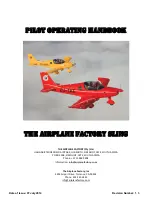
15
ENGLISH
The sail and the lines do not age in the same way or at the same
rate; it is possible that you may have to change part or all of the
lines during the wing’s life. For this reason it is important to do
regular inspections so that you know the exact condition of all of the
components of your glider. We recommend that inspections are car-
ried out by a qualified professional.
You alone are responsible for your flying kit and your safety depends
on it. Take care of your equipment and have it regularly inspected.
Changes in inflation/ground handling/flying behaviour indicates the glid-
ers aging, if you notice any changes you should have the wing checked
before flying again.
These are the basic elements of the check up (full details and per-
missable figures can be found on our website):
Porosity is measured with a porosity meter, the time taken by a
certain volume of air to go through a certain surface of the cloth. The
time in seconds is the result. A measurement is done in a several
places on the top surface along the span of the glider behind the
leading edge.
The tearing resistance of the cloth - A non-destructive test following
the TS-108 standard which specifies minimum tear strength for sky
diving canopies should be made using a Bettsometer. (B.M.A.A. Ap-
proved Patent No. GB 2270768 Clive Betts Sails)
Strength of the lines - An upper, middle and lower A line, along with a
lower B and a lower C (and lower D if applicable) line should be tested
for strength. Each line is tested to breaking point and the value re-
corded. The minimum value is 8 G for all lower A+B lines and 6 G for
all lower remaining lines, calculated from the maximum certified flying
weight of the glider. The added minimum strength for the middle lines
and for the top lines should be the same. If the breaking strength is
too close to the minimum value calculated, the professional should
give a period after which you will have to test the strength of the
lines again.
Wing Repairs
Amateur repairs can do more harm than good. Always let a regis-
tered dealer or the manufacturer carry out major glider repairs.
If you damage the sail:
If the rip is small, you can fix it yourself. You’ll find all the materials
you need in the supplied repair kit. The fabric can be simply mended
with the sticky rip stop/spinnaker tape. When cutting out the patch
remember to allow ample overlap around the tear and round the
corners of the patch.
You can find more information about repairing your wing on the Ozone
website, including step by step instructions with pictures.
If you damage a line:
Any line that is damaged should be replaced. It is important that the
replacement line is from the same material, has the same strength
and the same length. You can check its length against its counter-
part on the other side of the wing, to make sure that it is symmetri-
cal. Once the line has been replaced, inflate and check the glider
before flying. If you do not have access to an Ozone dealer you can
order individual lines at www.flyozone.com
MAINTENANCE CHECKS
Your wing, like a car, should be technically checked to ensure proper
airworthiness.
Your wing should be checked by a qualified professional for the first
time after 24 months, or after 100 hours. However, if you are a
frequent flyer (more than 80 hrs per year), then we recommend, that
you get your glider checked annually.
The checker should inform you about the condition of your glider and
if some parts will need to be checked or changed before the next
normal service check period.













































